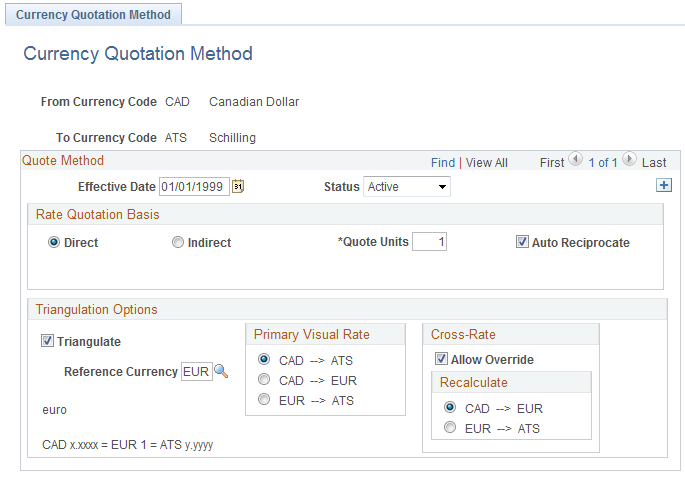Defining Currency Quotation Methods
This section discusses how to define currency quotation methods.
|
Page Name |
Definition Name |
Usage |
|---|---|---|
|
CURR_QUOTE_PNL |
Set up and maintain a currency quotation method for each from-currency and to-currency pair. |
Use the Currency Quotation Method page (CURR_QUOTE_PNL) to set up and maintain a currency quotation method for each from-currency and to-currency pair.
Navigation:
This example illustrates the fields and controls on the Currency Quotation Method page. You can find definitions for the fields and controls later on this page.

A currency quotation method, defined for an exchange rate, stores data that determines how the application interprets a visual rate entered by a user (or multiple visual rates, in the case of triangulated exchange rates) into the RATE_MULT and RATE_DIV values stored on the Market Rate Data table. Conversely, a currency quotation method also determines how the stored RATE_MULT and RATE_DIV values are interpreted into the visual rate displayed to the user.
The quotation method can be direct or indirect, and it can be non-triangulated or a triangulated conversion using a third reference currency. The currency quotation method also determines the quotation units of the from-currency.
See Understanding Conversion Factor Fields and the Visual Rate.
It is not necessary to define a currency quotation method for every exchange rate. If, during maintenance of market rates, no quotation method is found for an exchange rate, the page logic assumes the following defaults:
The exchange rate is direct.
The quotation units are equal to 1.
The exchange rate is not triangulated.
Note: This use of default values supports backward compatibility with previous exchange rate data, including calculated reciprocal rates, if your implementation requires them.
See Understanding Conversion Factor Fields and the Visual Rate.
Note: You can view the currency quotation method for an exchange rate on the Exchange Rate Detail page while working on the Market Rate page.
Field or Control |
Description |
|---|---|
Direct and Indirect |
In the Rate Quotation Basis section, indicate whether the rates for this currency pair are quoted directly or indirectly. For example, when defining a currency quotation method for USD and FRF:
Even currency quotation methods for currency pairs that triangulate must be classified as either direct or indirect. In this case, the value is used to display the calculated cross rate. Support for indirect and direct quotation methods allows applications to eliminate use of calculated reciprocal rates by using a single rate by which you either divide or multiply, depending on whether the conversion method is direct or indirect. |
Quote Units |
Enter a quote unit for the exchange rate, as is common business practice for some currencies. This field can have any value, but is usually a power of 10. Sometimes called scaling factors, quote units are often used to preserve more decimal precision. For example, the exchange rate between Swiss francs (CHF) and Deutsche marks (DEM) may be stated as 100 CHF = 119.335 DEM instead of 1 CHF = 1.19335 DEM. |
Auto Reciprocate |
Select to automatically create or update the rate for the reciprocal currency pair on the Market Rate page whenever an exchange rate is added or updated. For example, if you create a currency quotation method for USD to EUR. The reciprocal currency quotation method for EUR to USD is automatically created, regardless of this setting. When you create a rate for USD to EUR on the Market Rate page, the EUR to USD reciprocal rate is automatically created if this Auto Reciprocate option is selected for the currency pair. If the either rate for the currency pair is updated on the Market Rate page, the reciprocal rate is updated as long as the Auto Reciprocate option is selected for one of the currencies in the pair. |
Triangulate |
Select to triangulate conversions between this currency pair using a reference currency. |
Reference Currency |
Enter the reference currency for a triangulated conversion. |
Primary Visual Rate |
With triangulated currency pairs, there are three exchange rates to consider:
Select which of these three rates you want as the primary visual rate. This is the rate that displays on the primary pages and reports. For online applications, other components of the rate can be viewed and modified on the Exchange Rate Detail page. |
Allow Override |
For triangulated currency pairs, select to enable users to override the cross rates on the Market Rate page and Exchange Rate Detail page. |
Recalculate |
If the Allow Override option is selected, select to indicate which of the two other rates should be recalculated to bring the triangle back into balance. Because the triangulated rate is initially a calculated rate, if you allow it to be overridden, the rates that are used to initially calculate this rate must be recalculated. |